Natural Draft Gasifier (NDG) Stove
Krishna Kumar, India, December 2003
Krishna Kumar: I am final year student doing my Post graduation in (Energy Engineering) in Anna University. I completed my graduation in Mechanical Engineering Madras University. I am staying in the city of Madras in India.
I was on for a project for solar home ligthing in unelectrified villages of the state,where i found that almost all the villages is in dark and poverty. People living here not having money and all are uneducated.
There i found that there is abundance of firewood(Juliflora), which they cut and use for the cooking purpose.the method adopted by them is open
fire cooking which was very inefficient and produced a lot of smoke.
Hence i thought of doing my project in developing the stove which gives out less smoke burns the fuel in
an efficient manner.
The people do not have electricity so they cannot go for woodcutter. hence they have to use the wood as such choped from the forest hence i am trying to develop a natural draft gasifier based stove which burn fuel of greater size and not of briquetted or pelletted fuels.
I am trying to develop one such design such that the maximum size up to which the the fuel can be burned in a efficient manner.
I am staying in such a place where i could not get any guidance or i donot have proper instruments to monitor them.
Basically my project is using the Natural Draft Gasifier for cooking and thermal application. Actually I was on a survey for solar home
lighting and street lighting, on visiting many places in the villages I found that on improving the cooking standards in the villages in Tamil Nadu.Thats how I got the idea.
I have seen in manual dyeing units the temperature of water is around 60- 80 degree centigrade.They use open fire for their operation,which produces a lot of smoke and workers feel it difficult to stand beside and work.Hence I would like to use this NDG over there also.
I have fabricated the natural draft gasifier with conrete and coated inside with clay. I have made a trial run of it and it worked satisfactorlly.The flame reached to a height of 1-1.25ft above the top of the stove.
Then I tried with closing the top of the stovewith a lid and taking the gas seperately and burning it through a burner. but i was unsuccesful in burning the gas. The gas came out through the primairy air port and it did not gasify the wood inside.
I would like to know about the chimney effect and draft to create the gas to come out of the pipe.
Ron Larson: My experience with what might be similar is that the combustion chamber (which also serves as a chimney) needs to be about 150% as high as the diameter. If too short, combustion will not be complete (as you appear to be observing) and the pyrolysis gases will leave too much soot on surfaces you (I hope) are trying to heat up. Also with too short a combustion/chimney region, you will not develop a sufficiently good pressure difference and not draw enough primary air through your fuel supply (which I hope you are lighting from the top).
If the combustion area/chimney is too long, you are probably losing more useful energy than you need to. If you are not planning something useful
for the pyrolysis gases, the chimney can be very tall.
Lanny Henson: Your project sounds very interesting. To create draft or air flow I would suggest a minimum of 1 meter of draft. Measure the draft height by measuring from air intake to the top of the exhaust chimney, that is if the system is sealed (air tight).
| Questions from Lanny Henson |
Answers from Krishna Kumar
|
Thanks for telling us about your work to improve cook stoves in Tamil Nadu and other villages in India.
Can you give me more information?
|
I am yet to start the detailed readings on this I have noted the flame temperature to be 677 deg centigrade and the bed temperature was 1044 deg centigrade. I have yet to set the thermocouples for the detailed readings.
|
What kind of pots are used?
|
I am using alluminium pots.
|
Is cooking done indoors?
|
At present i am doing it on the open space
|
Is the cook stove also used for heating the house?
|
I could get you.
|
|
How far to the nearest electrical source to use power tools to build stoves and chimneys?
|
Is the place of installation for a village it is of
5-10 km away.
|
|
What raw materials are available to use for building stoves? Drums? kiln for ceramics/fire clay/ fire bricks? sheet metals? insulation? metal roofing?
buckets?
|
Clay is available in plenty,
because the houses here all are mud houses.
Hence the materials i have made of concrete.
And fired clay can also be used.
|
What are you drying in the manual drying units?
|
No, in manual dyeing units for the colouring of the
threads that are used in cloths making because there
plenty here in my state which is around 400 km from
the place I live.
|
How much do the cooking pots hold?
|
It holds 10 litres of water.
|
How many pots are used to cook a meal?
|
Maximum 3 pots are used |
What foods are cooked in poor areas, rice? corn? beans? wheat?
|
Usually rice is cooked and very few cereals. They grow poultry in almost all houses and they cook it.
|
If electric power is within 10 to 20Km, that is not too far to transport a stove. So practical stove design could use electricity in the construction. Steel drums can be cut and used to make stoves and NDG outer shells.
|
They do not have proper roads here, villagers are to wait for the bus which is travelling for very 2-3 hrs a day.the electricity prone areas near by are also not much developed.
|
| Are drums avaliable? |
Scrap materials maybe avalable ie. tin cans maybe available that can be used for the construction.
|
How many liters are you heating in the dyeing tanks?
|
700 litres of water |
Is there room to get a NDG under the drying units or do you need to flow into the side or down under the unit?
|
Yes i planning to keep it underneath
|
I am attaching the photos of the manual dyeing unit.
|
|
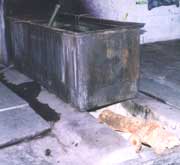 |
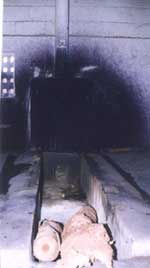 |
Krishna Kumar
krishnakumar_07@YAHOO.CO.UK
Anna University, Madras, India
Lanny Henson Dec 27, 2003:
Krishna,
You mentioned connecting a gasifier to a dye tank.
I have some suggestions to 1- reduce heat loss and to 2- improve the fire.
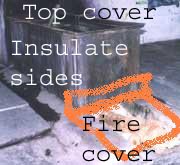 |
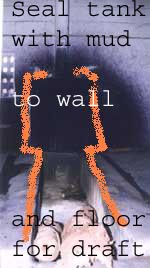 |
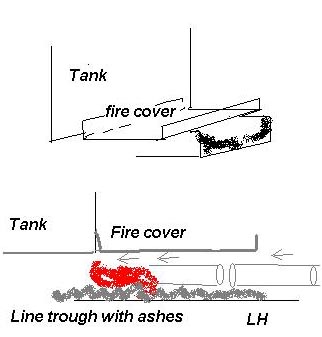 |
|
1-Reduce heat loss.
http://www.lanny.us/kk2c.jpg 17K
a-Cover the top of the tank when possible
b-Insulate the sides of the tank.
c-Line the trough with ashes for insulation.
Tell me more about the process. How long does the tank stay hot? Continuous?
Once a day? Once a week?
|
2- Improve the efficiency of the burn.
Seal the tank to the floor and wall and chimney with mud to maximize the
pressure of the draft.
http://www.lanny.us/kk1c.jpg 17K
http://www.lanny.us/kk3c.jpg 23K
|
|
Use this draft to pull the flow from your gasifier.
The draft should be sufficient to pull the flow down and up like siphoning.
There should be enough draft pulling to lay the gasifier on its side.
Also try using a fire cover over the trough to focus the supply air.
The draft should increase the velocity and create a blasting effect.
Back burn the wood as you feed it in.
Keep a small hot fire and keep a watch on your chimney exhaust.
Line the trough with ashes for insulation.
If this works design a horizontal gasifier to fit in the trough.
Lanny Henson
 |
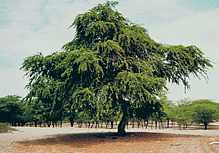 |
| Managing Prosopis juliflora (Vilayati babul): A Technical Manual (2000) Tewari, JC, Harris PJC, Harsh LN, Cadoret K and Pasiecznik NM. CAZRI, Jodhpur, India and HDRA, Coventry, UK. 96pp. ISBN 0 905343 27 1
|
Manual available for download here (PDF 12.7Mb)
|
A D Karve: Dear Mr. Krishna Kumar, there can be number of ready made solutions for solving the problem of smoke filled kitchens in rural India. I enclose a list of rural household technologies developed by us. You may find either the one or the other useful in your case.
.
Rural energy from agrowaste: The fraction of the total crop biomass, that is economically not useful, is called agrowaste. Its proportion can
vary from 20 to 70% of the total biomass.It is estimated that agriculture in India generates annually about 500 million tonnes of
agrowaste. ARTI has developed a number of technologies to utilise the agrowaste as domestic fuel. They are as follows:
Improved cookstoves: Woody agrowaste such as stalks of cotton and pegionpea are burnt directly in a woodburning cookstove. A traditional
rural cookstove, made of unfired clay, has a very low efficiency, it produces a lot of smoke and soot and it has a life of just a couple of
years. The cookstoves developed by ARTI not only have a high efficiency of about 25%, but they also reduce the indoor air pollution. Being made
of cement concrete, they last for at least 5 years.
Fuel briquettes from light Agrowaste: Because most agricultural species are herbaceous, agricultural waste is generally in the form of leaves
and thin stems. The act of threshing also results in generating powdery agrowaste. Agrowaste in these forms cannot be used as fuel in a wood
burning stove, but it can be converted into charcoal briquettes by using a charring kiln based on the oven and retort system. The charcoal
produced in this kiln can be easily powdered, and mixed with a suitablebinder, it can be extruded into char briquettes.
Sarai stove-and-cooker system: This is an assembly, which is capable of cooking a meal for a family of five using just 100 g of char briquettes.
A housewife, using a traditional wood-burning cookstove, would have to use about 3 kg wood for cooking the same amount of food.
User friendly biogas technology: The traditional biogas technology, based on cattle dung, is useful only to families having at least 6 to 8
heads of cattle. Because of the low rate of gas generation per unit mass of dung, and long retention time of about 40 days, the smallest domestic
digester has a volume of about 2000 litres. Feeding daily about 40 kg cattle dung into the digester and disposing of daily about 80 kg of
effluent slurry is a great bother. The new biogas plant developed by ARTI is much more user friendly. Having a capacity of 400 litres, it
uses daily just 2 kg of starchy agrowaste (e.g. rhizomes of banana, canna, nutgrass), non-edible seeds (e.g. Leucaena, Sesbania, tamarind,
mango kernels, spoilt grain), oilcake of nonedible oilseeds (Pongamia, Madhuka, castor), or leftover food. Its reaction time is just a few
hours. It produces just a couple of litres of watery effluent that is easy to dispose of.
Yours sincerely
Dr.A.D.Karve, President,
Appropriate Rural Technology Institute
Pune, India.
TERI Southern Research Centre
A Gasifier System for the Silk Dyeing Industry a case study in Bangalore August 2002
Biomass Gasification for the Silk Industry: India 1995-2002, Tata Energy Research Institute (TERI) (pdf)






